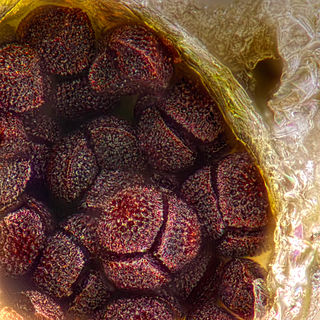
Basidiomycota is one of two large divisions that, together with the Ascomycota, constitute the subkingdom Dikarya within the kingdom Fungi. Members are known as basidiomycetes. More specifically, Basidiomycota includes these groups: agarics, puffballs, stinkhorns, bracket fungi, other polypores, jelly fungi, boletes, chanterelles, earth stars, smuts, bunts, rusts, mirror yeasts, and Cryptococcus, the human pathogenic yeast.

An ascus is the sexual spore-bearing cell produced in ascomycete fungi. Each ascus usually contains eight ascospores, produced by meiosis followed, in most species, by a mitotic cell division. However, asci in some genera or species can occur in numbers of one, two, four, or multiples of four. In a few cases, the ascospores can bud off conidia that may fill the asci with hundreds of conidia, or the ascospores may fragment, e.g. some Cordyceps, also filling the asci with smaller cells. Ascospores are nonmotile, usually single celled, but not infrequently may be coenocytic, and in some cases coenocytic in multiple planes. Mitotic divisions within the developing spores populate each resulting cell in septate ascospores with nuclei. The term ocular chamber, or oculus, refers to the epiplasm that is surrounded by the "bourrelet".

Neurospora crassa is a type of red bread mold of the phylum Ascomycota. The genus name, meaning 'nerve spore' in Greek, refers to the characteristic striations on the spores. The first published account of this fungus was from an infestation of French bakeries in 1843.

Sordaria fimicola is a species of microscopic fungus. It is commonly found in the feces of herbivores. Sordaria fimicola is often used in introductory biology and mycology labs because it is easy to grow on nutrient agar in dish cultures. The genus Sordaria, closely related to Neurospora and Podospora, is a member of the large class Sordariomycetes, or flask-fungi. The natural habitat of the three species of Sordaria that have been the principal subjects in genetic studies is dung of herbivorous animals. The species S. fimicola is common and worldwide in distribution. The species of Sordaria are similar morphologically, producing black perithecia containing asci with eight dark ascospores in a linear arrangement. These species share a number of characteristics that are advantageous for genetic studies. They all have a short life cycle, usually 7–12 days, and are easily grown in culture. Most species are self-fertile and each strain is isogenic. All kinds of mutants are easily induced and readily obtainable with particular ascospore color mutants. These visual mutants aid in tetrad analysis, especially in analysis of intragenic recombination.
Heterothallic species have sexes that reside in different individuals. The term is applied particularly to distinguish heterothallic fungi, which require two compatible partners to produce sexual spores, from homothallic ones, which are capable of sexual reproduction from a single organism.

Aspergillus nidulans is one of many species of filamentous fungi in the phylum Ascomycota. It has been an important research organism for studying eukaryotic cell biology for over 50 years, being used to study a wide range of subjects including recombination, DNA repair, mutation, cell cycle control, tubulin, chromatin, nucleokinesis, pathogenesis, metabolism, and experimental evolution. It is one of the few species in its genus able to form sexual spores through meiosis, allowing crossing of strains in the laboratory. A. nidulans is a homothallic fungus, meaning it is able to self-fertilize and form fruiting bodies in the absence of a mating partner. It has septate hyphae with a woolly colony texture and white mycelia. The green colour of wild-type colonies is due to pigmentation of the spores, while mutations in the pigmentation pathway can produce other spore colours.

Fungi are a diverse group of organisms that employ a huge variety of reproductive strategies, ranging from fully asexual to almost exclusively sexual species. Most species can reproduce both sexually and asexually, alternating between haploid and diploid forms. This contrasts with most multicellular eukaryotes such as mammals, where the adults are usually diploid and produce haploid gametes which combine to form the next generation. In fungi, both haploid and diploid forms can reproduce – haploid individuals can undergo asexual reproduction while diploid forms can produce gametes that combine to give rise to the next generation.
Microbial genetics is a subject area within microbiology and genetic engineering. Microbial genetics studies microorganisms for different purposes. The microorganisms that are observed are bacteria and archaea. Some fungi and protozoa are also subjects used to study in this field. The studies of microorganisms involve studies of genotype and expression system. Genotypes are the inherited compositions of an organism. Genetic Engineering is a field of work and study within microbial genetics. The usage of recombinant DNA technology is a process of this work. The process involves creating recombinant DNA molecules through manipulating a DNA sequence. That DNA created is then in contact with a host organism. Cloning is also an example of genetic engineering.

The order Sordariales is one of the most diverse taxonomic groups within the Sordariomycetes.

David Dexter Perkins was an American geneticist, a member of the faculty of the Department of Biology at Stanford University for more than 58 years, from 1948 until his death in 2007. He received his PhD in Zoology in 1949 from Columbia University. A member of the National Academy of Sciences, he served as president of the Genetics Society of America in 1977. In a scientific career that spanned more than six decades, Perkins collaborated on more than 300 papers. His associates included many graduate students and postdoctoral fellows who went on to scientific careers throughout the world.
The mating-type locus is a specialized region in the genomes of some yeast and other fungi, usually organized into heterochromatin and possessing unique histone methylation patterns. The genes in this region regulate the mating type of the organism and therefore determine key events in its life cycle, such as whether it will reproduce sexually or asexually. In fission yeast such as S. pombe, the formation and maintenance of the heterochromatin organization is regulated by RNA-induced transcriptional silencing, a form of RNA interference responsible for genomic maintenance in many organisms. Mating type regions have also been well studied in budding yeast S. cerevisiae and in the fungus Neurospora crassa.

Established in 1960, the Fungal Genetics Stock Center is the main open repository for genetically characterized fungi. The FGSC is a member of the World Federation for Culture Collections and is a leading collection in the US Culture Collection Network Research Coordination Network.

The tetrad is the four spores produced after meiosis of a yeast or other Ascomycota, Chlamydomonas or other alga, or a plant. After parent haploids mate, they produce diploids. Under appropriate environmental conditions, diploids sporulate and undergo meiosis. The meiotic products, spores, remain packaged in the parental cell body to produce the tetrad.
Bernard Ogilvie Dodge was an American botanist and pioneer researcher on heredity in fungi. Dodge was the author of over 150 papers dealing with the life histories, cytology, morphology, pathology and genetics of fungi, and with insects and other animal pests of plants. He made the first studies of sexual reproduction in the common bread mold, Neurospora.
Homothallic refers to the possession, within a single organism, of the resources to reproduce sexually; i.e., having male and female reproductive structures on the same thallus. The opposite sexual functions are performed by different cells of a single mycelium.

Podospora is a genus of fungi in the family Podosporaceae. Fossils of Podospora have been reported from 12 million year old rocks from central England.
Zopfiella is a genus of fungi within the Lasiosphaeriaceae family.
The Ceratostomataceae are a family of fungi in the phylum Ascomycota, class Sordariomycetes, subclass Hypocreomycetidae and order Coronophorales.
Sphaerodes is a genus of fungi within the Coronophorales order but it has not been placed within a family.

The Coniochaeta are a genus of pleomorphic yeasts of the order Coniochaetales and are pathogens of trees. Some species have also been found to form endophytic associations within plants in which they live inside plant tissues but do not actually harm the organism. They can take the form of pink to brown colonies, hyphae, conidiophores or sclerotia. In 2013, the Lecythophora were merged with the Coniochaeta, following suggestions by Ziauddin Khan et al.













